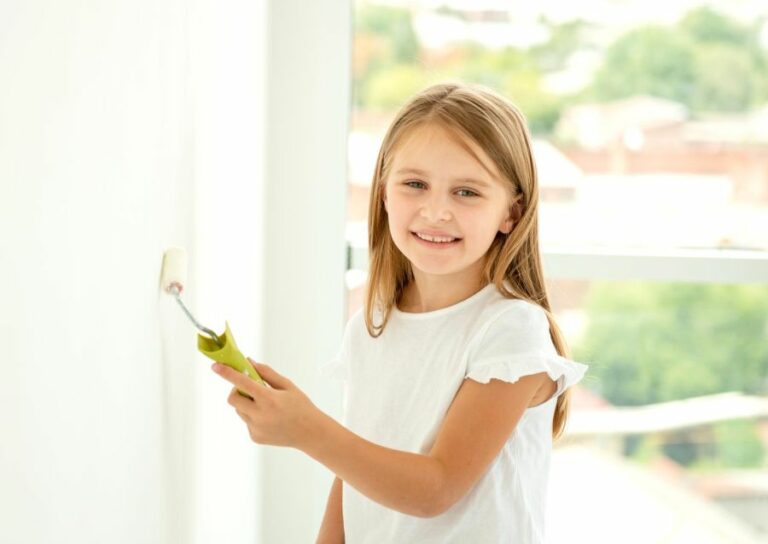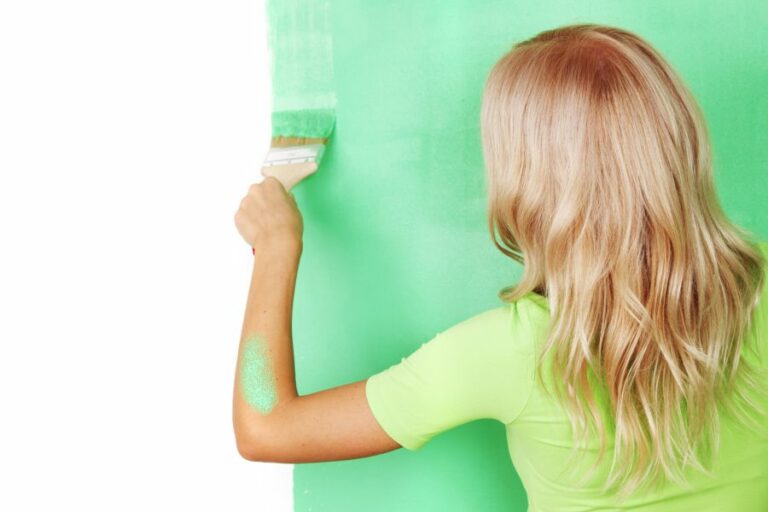Eco-Friendly Indoor Paint Choices, 25 Things You Should Know
Eco-friendly indoor paint choices are becoming more popular, and for good reason. Not only are they better for the environment, but using them can improve the air quality inside your home. If you’re looking to make a positive impact on both your health and the planet, we’ve got you covered with the best eco-friendly paint options available.
Eco-friendly indoor paint choices:>
Eco-friendly indoor paint choices include water-based paints (acrylic and latex), natural paints (milk paint, lime wash, and clay paint), and low- or zero-VOC paints. These options offer lower VOC levels, are made from renewable ingredients, and reduce harmful emissions, making them a safer and environmentally friendly alternative to conventional paint products.

Ready to give your home a fresh coat of paint while staying kind to our planet? Dive into our guide on eco-friendly indoor paint choices, and discover the benefits and options available to create a healthier living space. Read on to make a sustainable and stylish choice!
Contents
- 1 Sustainable Interior Paint Options
- 2 Discover the Top Eco-Friendly Paint Varieties
- 3 Exploring Environmentally Friendly Paints
- 4 Eco-Conscious Paint Alternatives for Your Home
- 5 Evaluating the Benefits of Eco-Friendly Paints
- 6 Behr Paint: A Greener Option for Your Space
- 7 Sherwin Williams: Offering Zero VOC Paint Solutions
Sustainable Interior Paint Options
• Why Choose Environmentally Friendly Paints?
In recent years, there has been a growing concern regarding the impact of conventional paint products on our health and the environment.
Traditional paints often contain volatile organic compounds (VOCs), which can cause a variety of health issues, including respiratory problems and headaches. Moreover, these VOCs contribute to air pollution and climate change.
To address these concerns, the paint industry has developed a range of eco-friendly paint options, which offer several benefits over their conventional counterparts.
• Water-based Paints: A Safe and Effective Choice
One of the most popular eco-friendly paint options is water-based paints, which use water as their primary solvent instead of harmful chemicals. These paints have significantly lower VOC levels compared to their oil-based counterparts, making them a safer choice for both your health and the environment.
Some popular water-based paints on the market include:
- Acrylic paint: Acrylic paints, also known as emulsion paints, are water-based and contain low VOC levels. They are versatile, easy to apply, and suitable for various surfaces, including wood, metal, and concrete. Acrylic paints are durable, fast drying, and resistant to moisture and ultraviolet (UV) radiation.
- Latex paint: Similar to acrylic paints, latex paints also use water as their primary solvent, offering a low-VOC alternative to oil-based paints. Latex paints are known for their smooth finish, excellent adhesion, and long-lasting results.
• Natural Paints: A Holistic Approach
Natural paints, as the name suggests, are made from natural, renewable ingredients, such as plant extracts, minerals, and clays. These paints tend to be free of synthetic chemicals and toxic substances, making them an excellent choice for those looking to minimize their ecological footprint.
Some common types of natural paints you can consider include:
- Milk paint: Made from a blend of casein (a milk protein), lime, and natural pigments, milk paint is a versatile and eco-friendly option suitable for various surfaces. It offers a distinctive, textured finish and can be easily adapted to different styles and preferences. Additionally, milk paint is biodegradable and non-toxic, making it a safe choice for both indoor and outdoor use.
- Lime wash: Derived from limestone, lime wash is a breathable, natural paint that is perfect for use on mineral-based surfaces such as brick, stone, and plaster. Due to its unique properties, lime wash can help regulate humidity in a room, creating a comfortable and healthy living environment. This paint option is not suitable for wood or other non-mineral surfaces.
- Clay paint: Comprised of clay, water, and pigments, clay paint offers an earthy, textured finish that adds depth and character to your walls. Clay paint is known for its excellent coverage, natural mold resistance, and ability to filter indoor air pollutants.
The United States Environmental Protection Agency (EPA) provides additional resources on eco-friendly paints and examples of how they can contribute to improved indoor air quality.
• Low- and Zero-VOC Paints: Reducing Harmful Emissions
Many water-based and natural paint options already boast low VOC levels. However, some manufacturers go a step further by offering low- and zero-VOC paint products specifically designed to minimize harmful emissions.
These paint options have been formulated to meet strict environmental standards, making them an ideal choice for those seeking a truly green paint solution.
Keep in mind, though, that while low- and zero-VOC paints can help reduce air pollution and improve indoor air quality, some individuals may still be sensitive to the materials used in these paints.
• Tips for Choosing Eco-Friendly Paints
When selecting an eco-friendly paint for your home, consider the following tips:
- Look for certifications: It is essential to choose paint products that have been certified by reputable organizations which can vouch for their eco-friendliness. Some reliable certifications to look for include Green Seal, Greenguard, and Ecolabel.
- Prioritize local manufacturers: Whenever possible, opt for paint products from local manufacturers to reduce the carbon footprint associated with transportation.
- Research ingredients: Do your homework on the ingredients used in different paint products to ensure they align with your environmental and health goals.
- Test before you buy: It is always a good idea to test a small sample of paint on your wall before making a significant purchase to ensure you are satisfied with the color, texture, and finish.
In conclusion, eco-friendly indoor paint choices have come a long way in recent years, offering a variety of safe, effective, and aesthetically pleasing options.
As more people become environmentally conscious, we can expect further innovations and improvements in this area, making it even easier to make responsible choices when refreshing our living spaces.
Discover the Top Eco-Friendly Paint Varieties
When it comes to painting your home, choosing the right type of paint is a crucial aspect. As more people are becoming environmentally conscious, the demand for eco-friendly paint options has increased.
• Natural Paints: A Perfect Blend of Nature and Science
Natural paints are made from ingredients sourced from nature, such as plant oils, plant dyes, clay, and chalk. These paints are free from volatile organic compounds (VOCs) – harmful gases emitted by some chemical-based paints. The absence of VOCs makes them a healthy and environmentally friendly choice.
The Earthpaint brand is a popular natural paint option worth considering.
U.S. Environmental Protection Agency offers comprehensive information on VOCs and indoor air quality.
– Pros
- Eco-friendly: Natural paints are biodegradable and have a low impact on the environment.
- Health benefits: Free of toxic chemicals, natural paints do not cause respiratory issues or other health-related issues associated with traditional paints.
- Odorless:** The absence of VOCs provides a pleasant and odor-free painting experience.
– Cons
- Limited color range: Due to their natural ingredients, these paints may have a limited color palette compared to conventional paints.
- Thickness: Natural paints can be thicker than conventional paints, which may require more effort during application.
From personal experience, I recommend trying Earthpaints Lime Paint as it offers a wide range of colors and a smooth application.
• Low-VOC or Zero-VOC Paints: Striking a Balance
While not as eco-friendly as natural paints, low-VOC or zero-VOC paints are a readily available alternatives. These paints emit fewer VOCs than traditional paints, making them an environmentally friendlier choice.
– Pros
- Wider color range: These paints offer a more extensive color palette than natural paints.
- Easier application: They have a similar consistency to conventional paints, making them easy to apply.
– Cons
- Not entirely eco-friendly: They still contain some synthetic chemicals, albeit at lower levels.
Benjamin Moores Natura is a popular choice for low-VOC paints, while Sherwin-Williams’ Harmony is known for offering zero-VOC options.
• Milk Paint: A Historical Favorite
Milk paint, made from milk protein (casein) combined with natural pigments, has been used for centuries. This biodegradable and non-toxic paint is gaining popularity due to its environmentally friendly nature.
– Pros
- Eco-friendly: Milk paint is biodegradable and does not emit VOCs.
- Natural appearance: The finish appears more authentic and organic compared to conventional paints.
– Cons
- Limited use: It is recommended for porous surfaces, making it unsuitable for some applications.
- Short shelf-life: The paint does not typically last as long as other alternatives once mixed.
I recommend trying The Real Milk Paint Co. products for a wide variety of colors and easy-to-follow mixing instructions.
• Conclusion
Ultimately, the most eco-friendly type of paint will be natural paints as they are free from toxic chemicals and derived from natural ingredients. However, low-VOC and zero-VOC paints and milk paint can be suitable alternatives, depending on the project’s specific requirements and the desired finish.
By choosing to use eco-friendly paint options, not only will you contribute to a healthier environment, but you will also create an indoor living space free of harmful chemicals.
Type of Paint | Environmental Impacts | Eco-friendliness |
|---|---|---|
Traditional Oil-based Paints | High Volatile Organic Compounds (VOCs), potentially harmful to the environment | Low |
Water-based Paints | Lower VOCs, some use renewable resources | Medium |
Low-VOC or Zero-VOC Paints | Minimal VOCs, less harmful impact on air quality | High |
Natural or Organic Paints | Minimal or no VOCs, made from natural, sustainable ingredients | Highest |
Exploring Environmentally Friendly Paints
Conscious consumers are increasingly looking for ways to minimize their impact on the environment. From eco-friendly cleaning products to biodegradable food packaging, these environmental enthusiasts are seeking out more sustainable alternatives.
One such area in which green-minded individuals are investing is eco-friendly paint.
• What is Eco-Friendly Paint?
Eco-friendly paint is a type of paint that has been formulated to be less harmful to the environment than traditional paints. These paints are usually made from natural ingredients, have fewer volatile organic compounds (VOCs), and boast a lower environmental impact.
Major paint manufacturers and niche brands alike are offering eco-friendly paint options to cater to this growing market.
– Understanding VOCs and Why They Matter
Volatile organic compounds (VOCs) are chemicals that are released into the air as paint dries. They are known to contribute to air pollution, as well as causing headaches, dizziness, and other health issues.
The United States Environmental Protection Agency (EPA) provides more information about VOCs and their impact on indoor air quality. Eco-friendly paint options typically have lower VOC levels, making them a better choice for our health and the environment.
• Types of Eco-Friendly Paint
There are several types of eco-friendly paint options available for those keen to make a greener choice. Below, we will explore some popular types and their benefits.
– Natural Paints
Natural paints are made from naturally occurring materials such as clay, lime, or plant extracts. They are biodegradable and usually have zero or very low VOC content. Here are some popular natural paint options:
Clay Paint
Clay paint is made from natural clay and minerals, making it an excellent choice for those seeking an eco-friendly option. It is highly breathable, hypoallergenic, and offers stunning earthy colors.
Lime Paint
Lime paint is another natural alternative, and it has been used for centuries. It is made from limestone that has been crushed, burnt, and then turned into a putty-like substance. Lime paint is known for its breathability, resistance to mold and mildew, and beautiful, textured finishes.
– Recycled Paint
Recycled paint is made by collecting leftover paint, sanitizing it, and then reprocessing it into new paint. This process helps to conserve resources and reduce waste. Recycled paint can be a cost-effective and eco-friendly option; however, the color choice might be limited.
– Low-VOC and Zero-VOC Paints
Many paint manufacturers now offer low-VOC and zero-VOC paint options. These paints emit fewer harmful chemicals and VOCs than traditional paints, making them better for the environment and indoor air quality.
Be sure to check the labels when choosing a paint, as the term “low-VOC” can vary between manufacturers.
• Tips for Choosing Eco-Friendly Paint
When selecting an eco-friendly paint for your project, consider the following tips:
- Research different paint brands and compare their environmental benefits.
- Look for third-party certifications such as Green Seal, which ensures the product meets specific environmental standards.
- Check the VOC content of the paint, and opt for a low-VOC or zero-VOC option when possible.
- Consider using natural, recycled, or low-impact paint for your project.
Remember, eco-friendly paint is just one aspect of a sustainable building or renovation project. Be sure to explore other green products and practices, such as energy-efficient lighting and reclaimed materials, to further reduce your environmental footprint.
• In Conclusion
The growing demand for environmentally friendly products has led to a surge in innovative, eco-friendly paint options.
From natural paints made with renewable resources to low-VOC options that prioritize indoor air quality, there is an array of choices on the market for those who want to minimize their impact on the environment.
By researching, comparing, and investing in eco-friendly paint, you are choosing a healthier and more sustainable way to enhance your indoor living spaces.
Eco-Conscious Paint Alternatives for Your Home
Eco-friendly paint alternatives have become increasingly popular in recent years as more and more individuals and businesses choose to live and work in environmentally-conscious ways.
From their low volatile organic compounds (VOCs) to their sustainable production process, these paints offer a greener option compared to traditional paints.
• The Problem with Traditional Paints
Traditional paints typically contain a range of unnatural ingredients and chemicals, which can lead to harmful effects on the environment and human health over time. A primary concern with these paints is VOCs, which are emitted as harmful gases when the paint dries.
VOCs contribute to air pollution and can cause short and long-term health issues for those exposed to them. In addition, these paints often contain other hazardous ingredients, such as formaldehyde, ammonia, and benzene, all of which pose varying risks to personal and environmental health.
• Low-Volatile Organic Compound (Low-VOC) Paints
A major stride forward in the creation of eco-friendly paints has been the development of low-VOC paints. These types of paints contain reduced levels of VOCs, with many brands even claiming “zero-VOC” formulations, ensuring minimal risks to human health and the environment.
By adhering to stricter guidelines on VOC content, low-VOC paints have become a popular choice for eco-conscious consumers who wish to reduce their carbon footprint.
Some recommended low-VOC paint brands include:
- Benjamin Moore’s Natura line
- Sherwin-Williams’ Harmony line
- Behr’s Premium Plus line
It should be noted that low-VOC paints may still contain small amounts of VOCs, so it is important to examine the specific paint label for confirmation.
• Natural Paint Alternatives
Natural paint alternatives are another eco-friendly option, made up of natural ingredients such as clay, chalk, and plant-based dyes. These paints often have little to no VOC content and are biodegradable, easily allowing for a reduction in environmental impact.
In addition to being environmentally friendly, natural paints often have a unique, textured appearance, offering a distinct aesthetic compared to traditional paints.
An excellent resource for more information on natural paints is the US Environmental Protection Agency’s website.
– Milk Paint
Milk paint is a notable example of a natural paint alternative, made from a mixture of milk protein (casein), limestone, clay, and natural pigments. This type of paint, which dates back thousands of years, is non-toxic, biodegradable, and even water-resistant when dry.
Milk paint is ideal for use on furniture, wood, and porous surfaces, providing a durable and breathable finish.
– Lime Wash
Another common natural paint alternative is lime wash, which is made from slaked lime, water, and natural pigments. Lime wash has been used for centuries to paint buildings and protect surfaces from the elements.
It is known for its ability to create a unique, weathered appearance over time, as well as its breathable and antimicrobial properties. Specifically suited for exteriors, brickwork, stucco, and other masonry surfaces, lime wash is an excellent eco-friendly alternative.
• Recycled Paint
Lastly, recycled paints are an environmentally friendly option for those looking to lessen their impact on the planet. These paints are made up of leftovers from other projects or unwanted paint, combined and reformulated to create a new product with a lower environmental footprint.
By opting for recycled paint, you are helping to reduce waste and conserve resources while still obtaining a high-quality finish. One example of a high-quality recycled paint brand includes Earthwise Architectural Salvage.
• Conclusion
When it comes to choosing eco-friendly paint alternatives, there are a variety of options available to suit different tastes and requirements.
From low-VOC and natural paints to recycled options, these alternatives offer a more sustainable choice for individuals and businesses who want to reduce their environmental impact. By selecting eco-friendly paint, you can ensure that your space is not only comfortable and elegant but also kinder to the planet.
Evaluating the Benefits of Eco-Friendly Paints
Over the years, we have seen a surge in the demand for eco-friendly products, including paint. With growing concerns for the environment and our health, it is natural to wonder if making the switch to eco-friendly paint is worth it.
Let’s delve into the benefits, limitations, and considerations of using environmentally friendly paint.
• What is Eco-Friendly Paint?
Eco-friendly paint, sometimes referred to as natural paint, is a type of paint that has a low environmental impact. These paints are formulated with fewer volatile organic compounds (VOCs) and other harmful chemicals present in traditional paints.
VOCs are responsible for the strong, pungent odors in conventional paint, and they release toxic emissions that negatively impact indoor air quality and contribute to air pollution. Eco-friendly paint comes in a variety of types, such as:
- Water-based paint
- Plant-based paint
- Mineral-based paint
- Recycled paint
• Benefits of Eco-Friendly Paint
– Healthier Indoor Air Quality
One of the primary reasons people consider using eco-friendly paint is its positive impact on indoor air quality. As mentioned earlier, traditional paint contains VOCs that evaporate into the air, posing health risks such as headaches, dizziness, allergic reactions, and respiratory issues.
Eco-friendly paint has little-to-no VOCs, reducing the risk of these irritating and potentially dangerous side effects.
– Environmentally Conscious
Eco-friendly paint has a lesser environmental impact in comparison to conventional paint. The reduced emission of VOCs and hazardous chemicals helps curb air pollution and contributes to the conservation and sustainability of natural resources.
Additionally, many eco-friendly paints are made with natural, renewable, and biodegradable materials.
– Wide Range of Colors and Finishes
Gone are the days when eco-friendly paint meant sacrificing color options and finishes. Today, eco-friendly paint brands offer a wide array of colors and finishes to choose from, making it easier than ever to find the perfect hue and sheen for your space.
• Limitations of Eco-Friendly Paint
– Cost
Eco-friendly paints generally come with a higher price tag compared to their traditional counterparts. This higher cost can be attributed to the sourcing of sustainable, high-quality materials and the specialized manufacturing process. It is crucial to weigh the long-term benefits for your health and the environment against the initial higher investment.
– Durability
While many eco-friendly paints perform similarly to traditional paints, some users may find that certain types of eco-friendly paints are less durable or fade more quickly. It is essential to research and choose a reputable brand and product known for its durability to ensure a long-lasting application.
– Availability
Although eco-friendly paint has become increasingly popular in recent years, it is still not as widely available as traditional paint. You may need to search for specialty stores or order online to purchase these products, possibly resulting in additional shipping costs.
• What to Look for When Choosing Eco-Friendly Paint
To find the best eco-friendly paint for your needs, consider the following factors:
- Low VOC Content: Check the label for the VOC content to ensure you are choosing low-VOC or zero-VOC paint. The lower the VOC content, the fewer harmful emissions are released into the environment and your indoor air.
- Certifications: Look for third-party certifications and labels such as Green Seal, GREENGUARD, Cradle-to-Cradle, and Ecolabel. These certifications help ensure that the paint adheres to specific environmental and health standards.
- Sustainability: Choose paint made from renewable, biodegradable materials and environmentally responsible production processes. Some brands even offer paint made from recycled paint or by-products, further reducing waste.
- Performance: Consider paint that is durable, long-lasting, and easy to clean, which will help reduce the need for regular repainting and minimize overall paint consumption.
• Recommended Eco-Friendly Paint Brands
Some well-known eco-friendly paint brands include:
- Benjamin Moore: Their Natura and Aura lines offer zero-VOC, high-performance paint in a range of colors and finishes.
- Sherwin-Williams: Sherwin-Williams offers a line of environmentally conscious paint, including the zero-VOC product Harmony.
- ECOS Paints: With a unique focus on being environmental and health-friendly, ECOS Paints offers zero-VOC, non-toxic paint products.
• In Conclusion: Is Eco-Friendly Paint Worth It?
When considering the benefits of eco-friendly paint, like improved indoor air quality, reduced environmental impact, and ample color and finish options, the switch is certainly worth considering.
While there are limitations like cost and availability, the long-term benefits to your health and the environment can outweigh the initial investment. Do your research, carefully weigh your options, and choose a reputable, eco-friendly paint brand that aligns with your priorities and needs.
Behr Paint: A Greener Option for Your Space
When it comes to choosing paint for your home or office space, there’s a growing trend in prioritizing eco-friendliness along with aesthetics and durability. Behr is a renowned brand in the world of paints, consistently offering high-quality products.
But is Behr paint actually eco-friendly? Let’s delve into this aspect and discuss the various features that make paint eco-friendly, as well as how Behr performs in these areas.
• Low Volatile Organic Compounds (VOCs)
Volatile Organic Compounds (VOCs) are chemicals that easily evaporate and emit harmful gases into the surrounding atmosphere.
They are a primary cause of indoor air pollution and have been linked to numerous health hazards, such as headaches, dizziness, and even liver damage over prolonged exposure. In this regard, I highly recommend using paints with low or zero VOC levels.
Behr offers a range of low-VOC and zero-VOC products. Many of their paints, such as their Premium Plus line, meet or exceed the strictest industry standards in terms of low-VOC content.
For instance, the GREENGUARD Gold Certification signifies that a product has been tested and verified for optimal air quality performance, including low emission of VOCs. The Premium Plus line holds this prestigious certification.
• Recycled and Biodegradable Content
Using paints with recycled and biodegradable content not only minimizes the environmental impact during production but also contributes to waste reduction. As a responsible brand, Behr proactively works on incorporating recycled materials into its products.
For example, Behr’s Pro i300 line is made with a minimum of 20% post-consumer recycled content, ensuring that it is an eco-friendly choice for professionals and consumers alike.
• Responsible Resource Management
When it comes to a paint’s environmental impact, factors such as shipping, packaging, and resource management play a significant role. Companies that adopt eco-friendly practices, from production to waste management, are deemed more environmentally responsible.
Behr is part of the Masco Corporation family, which has been recognized for initiatives related to environmental responsibility. Masco Corporation consistently emphasizes the importance of adopting responsible practices throughout its supply chain and manufacturing processes.
With this in mind, we can assume that Behr follows similar guidelines and contributes to minimizing its overall environmental impact.
• Independent Certifications
Independent certifications are a great way to ensure that paints are eco-friendly, as they provide an unbiased evaluation of a product’s environmental performance. When selecting paint, look for certifications from reputable organizations like GREENGUARD or EcoLogo.
As mentioned earlier, Behr’s Premium Plus line possesses GREENGUARD Gold Certification. Other lines like Marquee, Ultra, and their Ceiling Paint also carry this certification. The presence of such certifications is an indication that Behr is genuinely committed to providing eco-friendly products.
• Conclusion: Is Behr Paint Eco-Friendly?
Taking all the factors mentioned above into account, it is safe to say that Behr paint is eco-friendly.
With a focus on manufacturing products with low or zero VOCs, incorporating recycled and biodegradable materials, and a commitment to responsible resource management, Behr has made significant strides in offering environmentally sustainable products.
The various independent certifications further strengthen this assertion.
In conclusion, if you are looking for an eco-friendly paint option for your spaces, Behr presents a range of products that can meet your requirements without compromising on quality and performance.
Sherwin Williams: Offering Zero VOC Paint Solutions
Sherwin Williams, a renowned and trusted paint brand, has been manufacturing high-quality paints since 1866. A common concern for homeowners and professionals alike is the presence of volatile organic compounds (VOCs) in paint.
VOCs can have harmful effects on human health and the environment. In response to this concern, Sherwin-Williams offers a range of low and no-VOC paint options for consumers.
• Understanding VOCs and Their Impact
Volatile organic compounds (VOCs) are emitted as gases from certain solids or liquids. They are found in a wide variety of building materials, such as paint, adhesives, and cleaning supplies. VOCs can cause short- and long-term health effects, including headaches, respiratory problems, and even cancer.
The United States Environmental Protection Agency (EPA) provides detailed information on VOCs and their associated risks here.
Reducing the VOC content in paints is important for both human health and environmental reasons. Low and no-VOC paints emit fewer harmful chemicals, improving indoor air quality and reducing the risk of health problems.
Additionally, using low and no-VOC paints contributes to lower ground-level ozone levels, which benefits the outdoor environment.
• Sherwin Williams and No VOC Paint Options
Sherwin-Williams offers several low and no-VOC paint options for consumers who want to minimize VOC content in their painting projects.
– Harmony Interior Acrylic Latex Paint
Harmony is a Sherwin Williams no VOC paint that comes in a variety of finishes, including flat, eggshell, and semi-gloss. This paint is specifically designed to improve indoor air quality by reducing VOC levels from potential sources, such as building materials, carpets, and fabrics.
I recommend Harmony for individuals with allergies, asthma, or other sensitivities, as it contains an antimicrobial agent that helps inhibit the growth of mold and mildew on the paint film.
– ProMar 200 Zero VOC Interior Latex
ProMar 200 Zero VOC paint is a popular choice among professional painters due to its high-quality performance and environmental benefits. This paint, as the name suggests, contains zero VOCs and offers excellent hide, coverage, and durability.
ProMar 200 Zero VOC is available in flat, eggshell, satin, and semi-gloss finishes.
This paint option is highly recommended for commercial and residential spaces, including schools, hospitals, and hotels, where maintaining a healthy indoor environment is a top priority.
– Duration Home Interior Acrylic Latex
Duration Home is another high-quality paint option from Sherwin Williams that offers a low VOC content. This paint is highly durable, stain-resistant, and easy to clean. Duration Home is available in matte, satin, and semi-gloss finishes.
Duration Home is a good choice for families with young children or pets due to its exceptional durability and washability. It is also ideal for high-traffic areas of the home, such as hallways, kitchens, and bathrooms.
• Conclusion
Sherwin-Williams offers several no and low-VOC paint options for consumers who want to reduce VOCs in their indoor environments. Among these options are low VOC paints such as Harmony and no VOC options like ProMar 200 Zero VOC.
These environmentally friendly paint options provide excellent performance while significantly reducing the harmful effects that VOCs can have on human health and the environment.
Whether you are a homeowner, a professional painter, or a business owner, choosing a low or no-VOC paint option from Sherwin-Williams will not only benefit the indoor air quality of the space but also contribute to a healthier environment for everyone.







